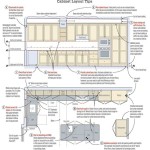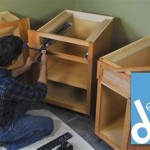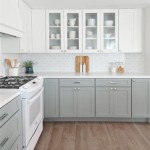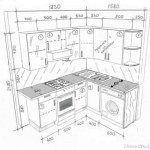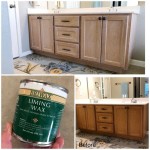DIY Kitchen Cabinets with Contact Paper
Renovating a kitchen can be a costly endeavor. However, achieving a fresh, updated look doesn't necessarily require a complete overhaul. Contact paper offers a budget-friendly and effective solution for revitalizing kitchen cabinets without the expense and commitment of replacing or repainting them. This article will guide you through the process of transforming your kitchen with contact paper, providing a step-by-step approach to achieve professional-looking results.
Gathering the Necessary Materials
Before beginning the project, gathering all the necessary tools and materials is crucial for a smooth and efficient workflow. This preparation prevents interruptions and ensures the project progresses seamlessly.
- Contact Paper: Choose a durable, high-quality contact paper in a desired pattern or solid color.
- Measuring Tape: Accurate measurements are essential for precise cutting and minimizing waste.
- Scissors or Utility Knife: Sharp cutting tools will ensure clean lines and a professional finish.
- Ruler or Straight Edge: A ruler or straight edge is vital for guiding the cutting tool and achieving straight cuts.
- Smoothing Tool or Credit Card: A smoothing tool or credit card helps to eliminate air bubbles and wrinkles during application.
- Cleaning Supplies: Thoroughly cleaning the cabinet surfaces is essential for proper adhesion.
- Pencil: A pencil is necessary for marking measurements and outlining cutting lines.
Preparing the Cabinet Surfaces
Proper surface preparation is paramount for achieving a smooth and long-lasting finish. Clean cabinets ensure optimal adhesion of the contact paper, preventing peeling and bubbling over time.
- Cleaning: Thoroughly clean the cabinet surfaces with a degreasing cleaner to remove any grease, grime, or residue.
- Drying: Allow the cabinets to dry completely before applying the contact paper. Moisture can interfere with adhesion and lead to bubbling.
- Repairing: Fill any holes or imperfections with wood filler and sand smooth for a flawless finish.
Measuring and Cutting the Contact Paper
Accurate measurement and precise cutting are crucial for achieving a professional-looking result and minimizing material waste.
- Measuring: Measure each cabinet surface precisely, adding a few extra inches to each side to allow for trimming and adjustments.
- Marking: Mark the measurements on the back of the contact paper using a pencil and a ruler.
- Cutting: Using sharp scissors or a utility knife and a straight edge, carefully cut along the marked lines, ensuring clean, straight edges.
Applying the Contact Paper
Careful application is key to achieving a smooth, bubble-free finish. Patience and attention to detail are essential during this stage.
- Peeling: Peel back a few inches of the contact paper backing, aligning it carefully with the edge of the cabinet surface.
- Smoothing: As you peel back the backing, use a smoothing tool or credit card to smooth out any air bubbles or wrinkles, working from the center outwards.
- Trimming: Once the contact paper is fully applied, trim any excess material using a utility knife or scissors for a clean, finished edge.
Troubleshooting Common Issues
While applying contact paper is generally straightforward, some common issues can arise. Understanding how to address these issues can prevent frustration and ensure a successful outcome.
- Air Bubbles: If air bubbles appear, carefully pierce them with a pin and smooth out the area with a smoothing tool.
- Wrinkles: If wrinkles occur, gently peel back the contact paper and reapply, smoothing as you go.
- Misalignment: If the contact paper is misaligned, carefully peel it back and reposition it, ensuring proper alignment before smoothing it down.
Maintaining Your Contact Paper Cabinets
Proper maintenance will prolong the life of your contact paper and keep your cabinets looking fresh.
- Cleaning: Wipe down the cabinets regularly with a damp cloth and mild detergent to remove any spills or dirt.
- Avoiding Abrasives: Avoid using abrasive cleaners or scrubbing pads, as these can damage the contact paper.
- Protecting: Protect the contact paper from excessive heat and moisture, which can cause it to peel or bubble.
Tips for Achieving Professional Results
Implementing these tips can elevate the final result, making your DIY project look professional and polished.
- Starting Small: Practice on a less visible area, such as the inside of a cabinet door, before tackling larger, more prominent areas.
- Working in Sections: For large surfaces, work in smaller sections to ensure proper alignment and avoid wrinkles.
- Using a Hair Dryer: A hair dryer can be used to warm the contact paper, making it more pliable and easier to apply around curves and corners.

How To Update Cabinets Using Contact Paper Al Kitchen Makeover Cover Apartment

I Used Contact Paper On My Whole Kitchen Makeover And Al S Part 2

Diy Contact Paper Kitchen Counters The Interior Diyer

Transform Your Kitchen With Contact Paper For Countertops Cabana State Of Mind

Kitchen Makeover Under 30 Diy Al Friendly

Diy Contact Paper Kitchen Update Part 1 Cabinets Roaming Home

7 Super Fast Mini Makeovers Kitchen Cabinets Makeover Contact Paper Diy

Diy Kitchen Cabinet Makeover For Ers Stars Streetlights

Amazing Er Friendly Kitchen Makeover On A Budget 150 Easy Diy W Contact Paper Cabinets

How To Update Cabinets With Contact Paper The Handyman S Daughter
Related Posts


